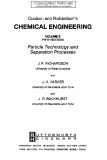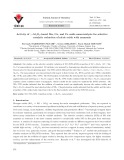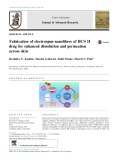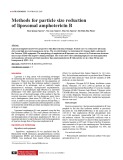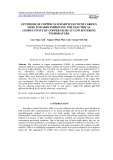
Particle size reduction
-
In this paper, we report a simple and fast method to produce uniform nano-sized Ag particles that can be dispersed in the oil phase by using oleic acid as solvent and capping agent. Oleylamine, a longchain amine that can act as an electron donor at elevated temperatures and is miscible with oleic acid, was selected as a reductant.
 6p
6p  viambani
viambani
 18-06-2024
18-06-2024
 1
1
 1
1
 Download
Download
-
Part 1 book "Coulson and Richardson's chemical engineering (Vol 2: Particle technology and separation processes)" includes content: Particulate solids; particle size reduction and enlargement; motion of particles in a fluid; flow of fluids through granular beds and packed columns; sedimentation; fluidisation; liquid filtration; membrane separation processes; centrifugal separations; leaching; distillation.
 320p
320p  muasambanhan09
muasambanhan09
 12-03-2024
12-03-2024
 6
6
 0
0
 Download
Download
-
Our studies on the selective catalytic reduction of NO (SCR-deNO) properties of M/γ-Al2O3 (M = Mn, Co, Cu) nanocatalysts are presented. All catalysts were prepared by homogeneous deposition precipitation using urea as the precursor for the precipitating agent. The SCR activity followed the order Mn/γ-Al2O3 > Cu/γ-Al2O3 > Co/γ-Al2O3. The nanocatalysts were characterized with respect to their texture (N2-BET), particle size (TEM), reducibility (H2-TPR), and acidity (NH3-TPD).
 10p
10p  langthannam
langthannam
 29-12-2021
29-12-2021
 9
9
 0
0
 Download
Download
-
In the present study copper oxide nanoparticles (CuO NPs) were synthesized using a hydrothermal method with ranolazine as a shape-directing agent. Ranolazine-functionalized CuO NPs were characterized by various analytical techniques such as scanning electron microscopy (SEM), Fourier transform infrared (FTIR) spectroscopy and X-ray diffraction (XRD). The SEM pattern confirmed the morphology of ranolazine-functionalized CuO NPs with well-defined rice-like structures. FTIR spectroscopy confirmed the interaction between CuO NPs and ranolazine.
 12p
12p  tudichquannguyet
tudichquannguyet
 29-11-2021
29-11-2021
 13
13
 1
1
 Download
Download
-
In this study, AgNPs are synthesized with the chemical reduction method. Ag+ is reduced by dextran. The size and shape of particles are studied by varying the temperature, time, and initial pH of the reaction. The antimicrobial activities of AgNPs/dextran are tested against X. oryae and P. oryzae.
 7p
7p  nguaconbaynhay10
nguaconbaynhay10
 20-02-2021
20-02-2021
 4
4
 1
1
 Download
Download
-
A versatile technique was implemented for the synthesis of silver nanoparticle using aqueous extract of leaves of Gymnema sylvestre. The reduction of silver nitrate to silver nanoparticle was confirmed by UV-Vis spectrophotometer showing a typical resonance (SPR) at about 390nm which is specific for ag NPs. In FT-IR analysis the strong band peak at 3355cm-1 in aqueous extract is vibration bands, which may be due to overlapping of amine N- H stretching bands.
 11p
11p  chauchaungayxua6
chauchaungayxua6
 26-06-2020
26-06-2020
 20
20
 0
0
 Download
Download
-
Particle size is important parameter affecting the composition, quality and final applications of the producer gas. Fine grained or fluffy feed stock may cause flow problems in the gasifier as well as an inadmissible pressure drop over the reduction zone and a high proportion of dust in the gas. To avoid such problems briquetted material considered for gasification. The developed gasifier was tested with different sizes of briquettes of 15, 30 and 45 mm width and 90 mm diameter. The volatile matter, fixed carbon and ash content of briquette were found as 71.87%, 17.07% and 4.
 4p
4p  nguaconbaynhay6
nguaconbaynhay6
 23-06-2020
23-06-2020
 7
7
 0
0
 Download
Download
-
The development of a protocol for biosynthesizing nanomaterial in an eco-friendly manner is a major concern in the field of microbial nanotechnology. In this study, microbial synthesis of silver nanoparticles (AgNPs) with a high level of bionanocatalytic activity was accomplished utilizing cell extracts of Penicillium digitatum FCMR-728 as the agents for reducing, capping and stabilizing. The presence of AgNPs was confirmed by an indication of a surface plasm on resonance band via UV–vis spectrum at 550 nm.
 14p
14p  nguaconbaynhay1
nguaconbaynhay1
 04-12-2019
04-12-2019
 15
15
 0
0
 Download
Download
-
Timolol maleate (TiM), a nonselective b-adrenergic blocker, is a potent highly effective agent for management of hypertension. The drug suffers from extensive first pass effect, resulting in a reduction of oral bioavailability (F%) to 50% and a short elimination half-life of 4 h; parameters necessitating its frequent administration. The current study was therefore, designed to formulate and optimize the transfersomal TiM gel for transdermal delivery.
 11p
11p  kequaidan1
kequaidan1
 16-11-2019
16-11-2019
 19
19
 2
2
 Download
Download
-
The present work reports preparation of irbesartan (IBS) loaded nanofibre mats using electrospinning technique. The prepared nanofibres were characterized by scanning electron microscopy, Fourier transform infrared spectroscopy, differential scanning calorimetry, X-ray diffraction analysis, in vitro diffusion and ex vivo skin permeation studies. FTIR studies revealed chemical compatibility of IBS and polyvinyl pyrrolidine (PVP K-30). SEM images confirmed formation of nanofibres wherein IBS existed in amorphous form as revealed by DSC and XRD analyses.
 7p
7p  kequaidan1
kequaidan1
 16-11-2019
16-11-2019
 24
24
 2
2
 Download
Download
-
Liposomal amphotericin B were prepared by thin film hydration technique. Particle size was reduced by ultrasonic device and high pressure homogeneous device. The size distribution was determined by dynamic light scattering by the Zetasizer ZS90 equipment. The morphology of amphotericin B liposomes was observed by Transmission electronic microscopy (TEM) with negative staining technique. The result shows that combining high-pressure homogenization and membrane extrusion provided monolayer liposomal amphotericin B with particle size less than 200 nm and homogenously (PDI < 0.3).
 4p
4p  caygaocaolon1
caygaocaolon1
 13-11-2019
13-11-2019
 10
10
 0
0
 Download
Download
-
In this study, CuO-doped material fabricated from rice husk ash and red mud was modified by CeO2 promoter and urea using the impregnation method. The obtained samples were investigated for catalytic degradation of aromatic derivatives (benzene, toluene, and p-xylene - BTX) at a temperature range of 275 to 450o C. This demonstrated that all samples were highly active in the BTX treatment.
 6p
6p  caygaocaolon1
caygaocaolon1
 13-11-2019
13-11-2019
 14
14
 2
2
 Download
Download
-
The synthesis of copper nanoparticles (CuNPs) by surfactant-assisted chemical reduction method was studied aiming to identify the content of PVP-surfactant corresponding to the size of copper particles. The crystallite size and phase of CuNPs were determined by Xray diffraction (XRD) analysis while transmission and scanning electron microscopy (TEM and SEM) were used to characterize the size of copper particles.
 6p
6p  vidonut2711
vidonut2711
 08-11-2019
08-11-2019
 15
15
 1
1
 Download
Download
-
The degree of particle size reduction was also dependent on the initial B4C size. It was found that the STS nanoparticles produced from milling is strongly bounded with the B4C particles forming the B4C/STS composite particles that can be used as a neutron absorbing nanocomposite. Based on the morphological evolution of the milled particles, a schematic pulverization model for the B4C particles was constructed.
 6p
6p  minhxaminhyeu5
minhxaminhyeu5
 30-06-2019
30-06-2019
 8
8
 1
1
 Download
Download
-
(bq) the book examines each of the major chemical processes, such as reactions, separations, mixing, heating, cooling, pressure change, and particle size reduction and enlargement -- in logically arranged alphabetical chapters, providing you with an understanding of the essential qualitative analysis of each.
 299p
299p  bautroibinhyen20
bautroibinhyen20
 06-03-2017
06-03-2017
 39
39
 5
5
 Download
Download
-
In this article, iron nanoparticles were synthesized by reduction of FeCl3.6H2O 0,045M using NaBH4 0,25M. Characteristics of obtained iron particales were studied by Transmission Electron Microscopy (TEM), X-ray diffraction method (XRD) and BET specific surface area, and maximum benzen adsorption. The TEM results of synthesized iron nanoparticales show that iron particles are spherical in shape and connected in chains, the particale size is about 3 - 50nm. The X-ray results show that synthesized nanoparticles is iron at 44.720.
 4p
4p  uocvong02
uocvong02
 24-09-2015
24-09-2015
 59
59
 3
3
 Download
Download
-
In this article, iron nanoparticles were synthesized by reduction of FeCl3.6H2O 0,045M using NaBH4 0,25M. Characteristics of obtained iron particales were studied by Transmission Electron Microscopy (TEM), X-ray diffraction method (XRD) and BET specific surface area, and maximum benzen adsorption. The TEM results of synthesized iron nanoparticales show that iron particles are spherical in shape and connected in chains, the particale size is about 3 - 50nm. The X-ray results show that synthesized nanoparticles is iron at 44.720.
 4p
4p  tuanloc_muido
tuanloc_muido
 11-12-2012
11-12-2012
 47
47
 4
4
 Download
Download
-
With a reduction of their size, nanoparticles reveal unique properties. A size reduction results in a substantial increase in the specific surface and the surface Gibbs free energy. This physical parameter of free energy reflects the fact that chemical reactivity increases rapidly as particle size diminishes. For example, water has a specific surface of 12.57x10-3 m2 /g at a diameter of one millimetre but the surface expands to 12.57x10+3 m2 /g at a diameter of one nanometre.
 87p
87p  quynho77
quynho77
 10-11-2012
10-11-2012
 43
43
 1
1
 Download
Download
-
Saterlie et al. Nanoscale Research Letters 2011, 6:217 http://www.nanoscalereslett.com/content/6/1/217 NANO EXPRESS Open Access Particle size effects in the thermal conductivity enhancement of copper-based nanofluids Michael Saterlie1, Huseyin Sahin2, Barkan Kavlicoglu2, Yanming Liu2, Olivia Graeve1* Abstract We present an analysis of the dispersion characteristics and thermal conductivity performance of copper-based nanofluids.
 7p
7p  dauphong13
dauphong13
 09-02-2012
09-02-2012
 37
37
 7
7
 Download
Download
CHỦ ĐỀ BẠN MUỐN TÌM









